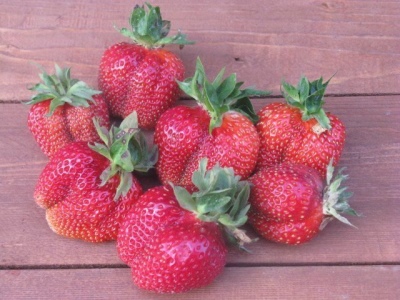
- Authors: Kokinsky stronghold of VSTISP in the Bryansk region, S.D. Aytjanova
- Taste: sweet and sour
- The size: very large
- Weight: 50-60 gr
- Yield: 10.46 t / ha
- Repairability: No
- Ripening terms: mid-late
- Appointment: universal
- Description of the bush: spherical, of medium density and rather strong stature
- Berry color: dark red
Rusich is a strawberry variety bred by the Kokinsky support point of VSTISP in the Bryansk region. The pioneer was the breeder S. D. Aitjanova. Rusich appeared as a result of crossing the Festivalnaya Daisy and Surprise Olympics varieties.
Description of the variety
This variety is characterized by the following features:
vigorous bush, spherical, medium density;
the leaves are colored dark green, small pimples are observed on the leaf blade, they shine a little;
peduncles are elastic, strong, located high above the ground, formed in large numbers;
inflorescences are miniature, umbrella type, raised above the leaves;
little mustache is formed.
Ripening terms
Rusich is a non-repairable variety with an average late ripening period.
Yield
The yield is above average: 10.46 tons of fruits can be harvested from 1 hectare.
Berries and their taste
The fruits are dark red in color, their shape is conical, slightly ridged. The variety belongs to large-fruited varieties, the weight of one berry reaches 60 g. The taste is sweet and sour, the pulp contains 8.5% sugar and no more than 0.8% acid. Taste properties are estimated at 4.5 points out of 5. There is a high marketability of the berries.
Growing features
To get a good harvest, there are several factors to consider.
It is a winter-hardy variety that can be grown in the Central region of Russia.
Watering the culture should be as needed, observe the golden mean between overdrying and waterlogging. Use warm water for watering.
If the bushes are planted in soil enriched with useful substances, then in the first year, feeding can be omitted. In subsequent years, the plant needs at least two feeding per season.
Bushes respond well to regular weeding and surface loosening of the soil.
The crop is not intended to be grown in pots at home.




Site selection and soil preparation
When landing, use a few guidelines:
when choosing a site, give preference to loose and cultivated types of soil with an acidity of 5.0-6.5 pH;
before planting, treat the seedling with Kornevin;
if seedlings are used as planting material, then the optimal time for planting in open ground is August;
when planting a plant in a humid and cool climate, plant bushes as rarely as possible; in hot regions, frequent planting is usually practiced;
seedlings are planted in holes closer to the surface, that is, the heart of the plant should be in the center of the hole;
if the planting material has too large roots, then they can be cut, but so that the length is a maximum of 8 cm;
if a specimen with a closed root system is planted, then it is removed and planted along with a lump of earth.

Pollination
Rusich has bisexual flowers, therefore it belongs to the self-pollinated varieties.

One of the important techniques in strawberry care is feeding. Regular fertilization guarantees a rich harvest. There are several different ways to feed strawberries, and each of them is designed for a specific period of plant development. During flowering, fruiting and after it, feeding should be different.

Diseases and pests
As a rule, the presented variety is not affected by the strawberry mite, which is one of the main enemies of strawberries. Rusich also has high immunity before defeat by gray rot.

Strawberries are often subject to many dangerous diseases that can seriously undermine their condition. Among the most common are powdery mildew, gray mold, brown spot, anthracnose and verticillosis. Before buying a variety, you need to inquire about its disease resistance.
Reproduction
This variety has an average or even zero degree of breeding intensity due to the low formation of whiskers. Some gardeners cultivate the crop by dividing the bush.
Reviews
Gardeners highly appreciate the taste properties of the Rusich berry. And also the variety is attractive for its frost resistance and the ability to keep its presentation for a long time. Of the minuses, the uneven shape of the berries is noted. It is believed that only experienced gardeners can engage in cultivating a variety; beginners are better off trying to grow simpler varieties.



















































































